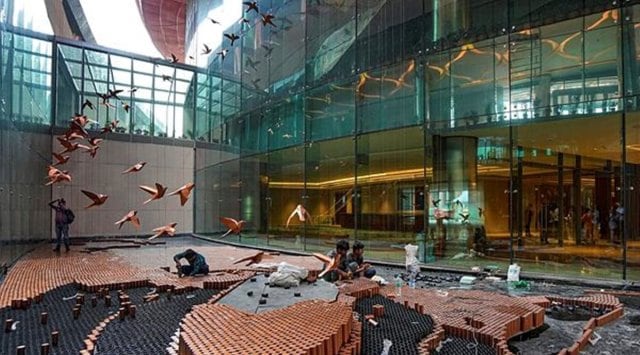
In the quest to have the “biggest” and the “largest” buildings and monuments in the world, the latest is the International Exhibition-cum-Convention Centre (IECC) at Pragati Maidan, New Delhi, “which has halls larger than the iconic Sydney Opera House.” At the building’s inauguration on July 26, the Prime Minister announced that we will have the world’s largest museum by next year. The recently opened 7.1 million sq ft Surat Diamond Bourse complex is said to surpass the Pentagon as the world’s largest office building. In 2018, the 182-m tall Statue of Unity, in Kevadia, Gujarat, was touted to be the world’s tallest statue.
As a society we have ourselves to blame. We have allowed our cities to be reduced to metonyms, where Agra is the Taj Mahal, Varanasi is the Kashi Vishwanath temple, Amritsar is the Sri Harmandir Sahib. We have allowed ourselves to forget that places are about people. Incidentally, the World Trade Centre twin towers in New York City were among the tallest buildings in the world, until they came down in 2001.
This attempt to show architectural muscle via superlatives such as “largest”, “tallest”, “biggest” and “fastest”, does something to the heart of India. Maybe it does puff up with pride, but does it also have room for beauty, humanism, tolerance, diversity? While there are ways to measure beauty, one touchstone principle that nails it comes from British-American design theorist Christopher Alexander who asked, “Will the building make for a beautiful ruin?” Can nature weave its way through our buildings?
If one were to pause and reflect on buildings that made one truly happy, at peace, joyous and elevated our thoughts to give them meaning, what would those spaces be? Can buildings, like wine, age gracefully? Is that why we are left with wonder when we visit our forts, stepwells, palaces, and havelis?
Philosopher Abhinava Gupta, in his discourse on Bharata’s Natyashastra, says, “A real work of art, in addition to possessing emotive charge, carries a strong sense of suggestion and the potential to produce various meanings. It can communicate through suggestions and evoke layers of meanings.”
We have yet to master that fine art of suggestion in our cities. Perhaps it’s all lost beneath the LED lighting in every government building today.
Like the vilayati kikar that invaded our forest floors for a century and created a monoculture, this rise of a monolithic architectural culture is worrying. We have crowded the vocabulary of our cities with superlatives, filled them with definitives and have completely missed the point. Our jharokas were spaces that not just let the air out but gave us multiple points to view, our jaalis left us chasing light and shadows, our fountains were where we shared secrets, the water shielding our voices. The attempt here is not to make a case for the past but to urge for unrehearsed spaces, for pools of knowing and not knowing, for landscapes that are both creative and ambivalent.
Recently, while flying into Delhi late at night, the city’s lights shimmered, and through the dense darkness, there were pink dots in multiple areas – it was the wedding season and almost every venue was dressed as a bride, in pink. It’s rather ironic that the Prime Minister should call Pragati Maidan, Bharat Mandapam.
We have reached out for the lowest denominator in using size as a descriptor for what we imagine to be an iconic building. When American architect Frank Gehry built the Bilbao Guggenheim Museum in the late ’90s, it was deemed as the ‘It’ building for his use of titanium and its undulating curves. The building is said to have made the Basque city world famous. However, Gehry rubbished this talk about the “Bilbao effect”, stressing instead the connection the building has to its surrounding, to its history, to its place. The building was his ode to Spain’s design hero, Antoni Gaudi, to its streets, the sea, the boats.
In the late 1960s, when the Indian government chose to make Pragati Maidan an exhibition complex, many architects were invited to build pavilions. Laurie Baker did one in brick, Charles Correa with Mahendra Raj built the Hindustan Unilever Pavilion, which looked much like a crumpled sheet of paper and Raj Rewal with Raj built the Hall of Nations and the Nehru Pavilion. While many of the pavilions were meant to be temporary, Rewal’s buildings stayed and became a fixture in the city. Superlatives are always used in comparative terms, and one is left wondering, does the new Pragati Maidan complex compare to the imaginations of the past?
Dutch architect Rem Koolhaas, in his authoritative book S,M,L, XL, says, “Architecture is a hazardous mixture of omnipotence and impotence…In the attraction for bigness is its potential to reconstruct the whole, resurrect the real, reinvent the collective and reclaim maximum possibility.”
None of this is happening in our country today. Our attraction for bigness is only a number.